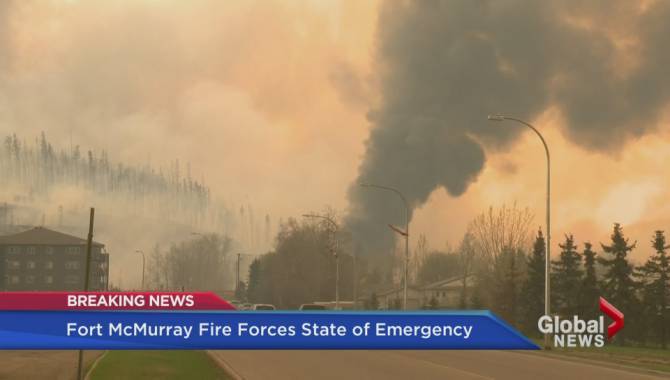
A fire fueled by shifting winds that forced more than 80,000 people to flee their homes and disrupted oil-sands operations in Western Canada is poised to expand.
The fire will probably grow to about 100 square kilometers (40 square miles), from around 80 now, Chad Morrison, a wildfire official, said Wednesday.
Suncor Energy, Nexen, Shell and Husky Energy are among companies reducing production and opening work camps to residents fleeing blazes in Alberta’s biggest-ever evacuation caused by a fire.
Inter Pipeline shut part of its system in the province. No deaths or injuries have been reported although 1,600 buildings have been damaged.
Reduced output from the world’s fourth-biggest crude producer helped lift benchmark oil prices, with West Texas Intermediate gaining as much as 2.3 percent in New York and Brent advancing 1.9 percent in London on Thursday.
Many residents of oil-sands hub Fort McMurray fled north to nearby sites where companies are flying out workers and making room for evacuees.
Shell has shut its 255,000 barrel-a-day Albian Sands mine and Suncor, Syncrude Canada and Connacher Oil & Gas. have also reduced output from the region.
More than 1 million barrels a day of oil sands production capacity may be affected by the blaze, according to company statements and data published in Alberta’s Spring Oil Sands Quarterly.
“My house and everything I own is gone,” Mike Marchand, a crane operator for Suncor, said in a phone interview from Edmonton, where he evacuated with his family after the trailer park where he lives in Fort McMurray went up in flames.
“I’ve never had anything like this happen.”
The wildfire is the latest blow to a province already grappling with the economic toll of a two-year oil price slump in one of the world’s most expensive places to extract crude.
More than 40,000 energy jobs have been lost in Canada since the price crash began in 2014. Some 250 firefighters, 10 helicopters and 17 air tankers have been deployed to fight the blazes around Fort McMurray, about 700 kilometers northeast of Calgary.
While lower temperatures may aid firefighters on Thursday, the blaze is expected to last at least until the weekend, Morrison said. The area will require years to recover, Scott Long, an emergency official, told reporters.
In the hardest-hit Fort McMurray neighborhoods, between 50 percent and 90 percent of homes have been lost, officials said.
Suncor said it brought down its base plant while cutting output from its Firebag and MacKay River oil sands operations.
Nexen shut its Long Lake facility, the company said on its website. The facility had already shut its 72,000 barrel-a-day upgrader and had reduced bitumen extraction after a Jan. 15 explosion.
Husky cut production at its Sunrise facility to 10,000 barrels a day from 30,000 after Inter Pipeline shut a diluent line to the plant, company Spokesman Mel Duvall said. Connacher cut about 4,000 barrels a day of output at its Great Divide project. Inter Pipeline said it shut part of its Corridor and Polaris systems.
The annual wildfire season in Western Canada started early this year after a dry winter and low spring rainfall. Officials have yet to identify a direct cause for the inferno, which quickly strengthened Tuesday afternoon and caught emergency responders by surprise.
An out-of-control blaze in 2011 caused an estimated C$700 million ($544 million) in damage after burning 47 kilometers and forcing some oil and gas operations to shut around Slave Lake, also in northern Alberta. Oil sands operations belonging to Canadian Natural Resources and Cenovus Energy were disrupted last year by a blaze near Cold Lake.
The current evacuation has been hindered by the unpredictability of the fire, which on Tuesday afternoon breached Highway 63, the main road in and out of Fort McMurray, south of the community.
Videos posted to Twitter as residents were trying to escape showed vast tracks of trees being swallowed by fire along Highway 63, the forest floor engulfed in flames and the sky thick with smoke. Helicopters flew overhead on their way to fight the fire.
Some who headed south to escape the blaze ran out of gasoline as refueling stations along the road were emptied. Alberta’s Transportation Department escorted a fuel tanker along the highway to assist stranded motorists, according to a Wednesday morning Twitter post.
Imperial Oil Ltd. is also supplying fuel to evacuees who fled north at the Wapasu Creek Lodge, which normally houses oil-sands workers, the company said on Twitter.
It’s too early to tally the damage, according to Premier Rachel Notley. The evacuation is the largest ever for the province tied to a fire, she said.
The provincial cabinet has approved C$2 million in upfront funding for the Red Cross and will continue to review further needs, she said.
“At this point the focus continues to be on the safety of the residents,” Notley told reporters at a Wednesday morning briefing in Edmonton. “Right now it’s people, then critical infrastructure, then stopping the fire.”
Fort McMurray is at the heart of the Athabasca deposit, one of three large bitumen reserves that make up Alberta’s oil sands where companies produce about 2.5 million barrels a day. Oil-sands crude prices rose after producers cut output.
The discount for Western Canadian Select, the heavy grade that includes oil-sands bitumen, shrank relative to West Texas Intermediate futures by 65 cents to $12.95 a barrel on Wednesday, according to Calgary brokerage Net Energy.
Light synthetic crude, also produced from the oil sands, flipped to a 75-cent premium to WTI from a five-cent discount Tuesday, according to Net Energy.
Canada’s Public Safety Minister Ralph Goodale pledged federal support for Alberta, while the national government dispatches military planes to the region.
Fort McMurray faces a long road ahead to rebuild, Goodale said at a briefing. “The recovery from this situation is going to take a considerable amount of time.”